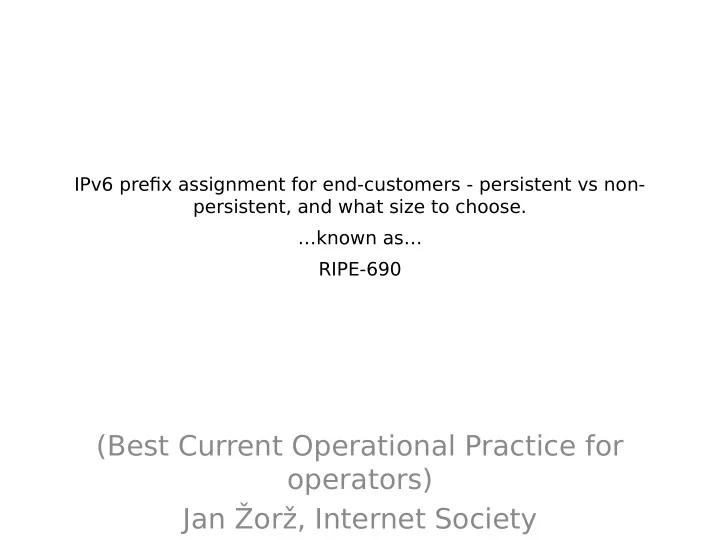

IPv6 prefjx assignment for end-customers - persistent vs non- persistent, and what size to choose. …known as… RIPE-690 (Best Current Operational Practice for operators) Jan Žorž, Internet Society
What is this document all about? • This document discusses the main issues related to the operational practices for the assignment of IPv6 prefjxes for end-customers. • Making wrong choices when designing your IPv6 network will sooner or later have negative implications on your deployment and require further efgort such as renumbering when the network is already in operation. The temptation to take “easy” approaches for quicker deployment should therefore be resisted.
Co-authors • Jan Žorž <zorz@isoc.org>, • Sander Stefgann <sander@stefgann.nl>, • Primož Dražumerič <Primoz.Drazumeric@telekom.si>, • Mark T ownsley <townsley@cisco.com>, • Andrew Alston <andrew.alston@liquidtelecom.com>, • Gert Doering <gert@space.net>, • Jordi Palet <jordi.palet@consulintel.es>, • Jen Linkova <furry@google.com>, • Luis Balbinot <lbalbinot@brfjbra.com.br>, • Kevin Meynell <meynell@isoc.org>, • Lee Howard <lee.howard@retevia.net>
T able of Content IPv6 Prefix Assignment for end-customers – BCOP persistent vs non-persistent and what size to 4 choose
A generic set of recommendations: a) IPv6 is not the same as IPv4. In IPv6 you assign a number of “n” /64 prefjxes to each end-customer site, so they are able to have as many subnets as they wish. You should not be concerned with exhausting the IPv6 addressing space, and you should think big when planning future requirements. If you need more space, you can go back to your Regional Internet Registry and providing your addressing plan justifjes it, you can obtain more IPv6 addresses.
A generic set of recommendations: b) If you want a simple addressing plan, you should consider these three options: 1) /48 for each end-customer. This will work very well for customers coming from other ISPs, those that have their own ULA, or have been using transition mechanisms. This will also be easier when you have a mix of customers using the same infrastructure, whether they are residential customers, SMEs or even large corporates. 2) Difgerentiate amongst types of customers, even if this will increase the complexity of your network and those of your customers, by ofgering /48 for business customers and /56 for residential customers. 3) A trade-ofg amongst the previous two options by reserving a /48 for residential customers, but actually just assigning them the fjrst /56. There a specifjc case for cellular phones to be assigned a single /64 per each PDP context, but this is out of scope of this document.
A generic set of recommendations: c) In order to facilitate troubleshooting and have a future proof network , you should consider numbering the WAN links using GUAs (Global Unicast Addresses), using a /64 prefjx out of a dedicated pool of IPv6 prefjxes. If you decide to use /127 for each point-to-point link, it is advisable to allocate a /64 for each link and just use one /127 out of it.
A generic set of recommendations: d) Non-persistent prefjxes are considered harmful in IPv6 as you can’t avoid issues that may be caused by simple end-customer power outages, so assigning persistent prefjxes is a safer and simpler approach. Furthermore, this avoids the need for expensive logging, increases your chances to ofger new business to customers, and decreases your customer churn.
A generic set of recommendations: Don’t complicate your IPv6 deployment.
A generic set of recommendations: otherwise you may end up with this…
Editing draft v.2
ACK’s IPv6 Prefjx Assignment for end- BCOP customers – persistent vs non- 12 persistent and what size to choose
Where to fjnd the doc… https://www.ripe.net/publications/docs/r ipe-690
Future work and ideas • “Running an email server and survive…” BCOP document • “Deployment of IPv6 in mobile networks” BCOP document • … more ideas needed. What operational practice would YOU like to see documented as BCOP??? IPv6 Prefjx Assignment for end- BCOP customers – persistent vs non- 14 persistent and what size to choose
Q&A Suggestions? Comments? Ideas? zorz@isoc.org
Recommend
More recommend